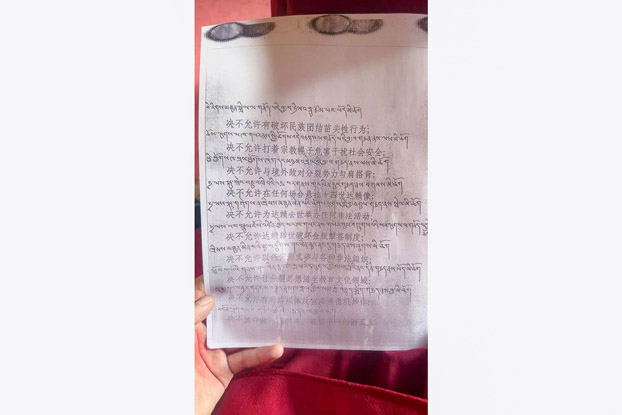(TibetanReview.net, Apr10’24) — Tibet’s exile spiritual leader, the Dalai Lama, said just recently that he was in great health and felt confident to live to be a centenarian. Nevertheless, the Chinese government is not taking chances and one of its provincial governments has issued what amounts to standard operating procedure-bans on the eventuality of his passing away.
A training manual has been distributed to Tibetan monasteries in Gansu province, banning photos of the Dalai Lama other “illegal religious activities and rituals,” reported the Tibetan service of rfa.org Apr 9. These bans have already been in place for decades across Chinese ruled Tibetan territories.
Gansu includes the historical northeastern Tibetan province of Amdo (or Domey)-area of Kanlho (Chinese: Gannan prefecture), home to some 200 large and small Tibetan Buddhist monasteries, according to the report.
The manual, which lists 10 rules for the Buddhist clergy to follow, also forbids disrupting the Chinese government-led process of recognizing the Dalai Lama’s reincarnation, the report said, citing a local Tibetan source.
The manual also forbids monks from engaging in activities that undermine national unity, or harm social stability in the name of religion, and also bans them from cooperating with so-called “separatist groups” outside the country, the report said.
Besides, it is said to ban “illegal organizations or institutions” from being allowed to enter monasteries while the education system for monks cannot harbour elements of “separatist ideology.” Neither of these terms lack clarity of legal definitions, making officials arbitrary judges of the violations in question.
The rules are also stated to prohibit the promotion of “separatist ideas” and the dissemination of “separatist propaganda” via radio, internet and television or by other means, as well as what is termed as “deception in the form of open or covert fraud”. These have always been taken to apply to any kind of opposition to or criticism of the Chinese rule or even government policies by the Tibetan people.
Copies of the manual were stated to have been distributed throughout Kanlho prefecture, which is home to about 415,000 Tibetans, which is just over 50% of the local population, with nearly 42% being Han Chinese, according to China’s 2000 census. It is not clear when exactly the manual was published or distributed.



